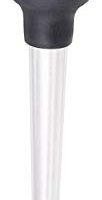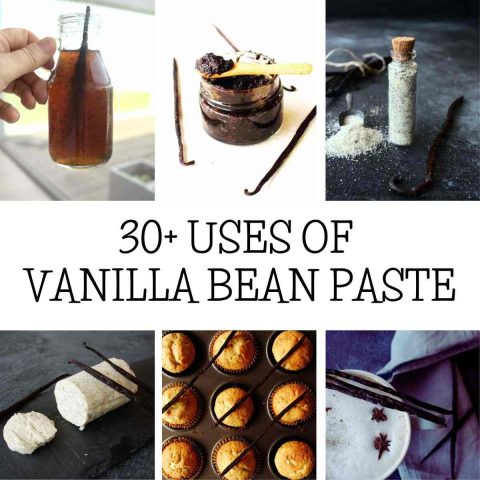This easy-to-make rose hydrosol is a pure botanical extract that enhances your skin and hair. Scented rose hydrosol is made of condensed water captured after steam distillation.

In this article you will learn:
- What is rose water hydrosol?
- How to choose your roses
- Which equipment do you need to make rose hydrosol
- step-by-step instructions
- Rose hydrosol vs. rose water
- How to use rose water
What is a rose hydrosol
Also known as floral water, plant water, or hydrolat, rose hydrosol is made by distillation. The steam made by boiling roses in water forces them to break their cells with volatile ingredients. The cooling process that follows condenses the steam into a liquid, which contains all the valuable substances.

rose hydrosol vs rose water
While both products use the same ingredients the process of making differs.
Rose water is a herbal infusion made by steeping rose petals in water. Use warm or hot water to steep your fragrant rose petals. Rose water contains all the water-soluble ingredients and minerals and carries the color of petals so from dark red to pink.
Rose water also carries the fragrance of rose petals. Although not very stable with a short shelf life. If kept refrigerated it can last up to one month.
Rose hydrosol on the other hand is transparent and has a longer shelf life. Thanks to the high steam temperature during the production process, the rose hydrosol is free of any microorganisms and considered sterile.
On the surface of rose water appear small drops of rose essential oil, thus carrying its benefits.
If you have no access to pesticide-free rose petals order dried organic rose petals online.

Rose hydrosol benefits
Rose hydrosol contains volatile substances and essential oils that are valuable for the skin and wellbeing. While Citronellol is an effective mosquito repellant, Citral has a strong antimicrobial effect.
Citronellyl Acetate on the other hand is responsible for the pleasant flavor and aroma of rose hydrosol.
Rose hydrosol possesses anti-bacterial and anti-inflammatory properties that nourish, hydrate, and soothe the skin.

Ease certain skin conditions
In addition, according to this study it may ease redness and irritation caused by rosacea, acne, and psoriasis and also soothe sunburns.
Rosewater hydrosol maintains the ph balance and acts as a toner to keep your pH balanced.
Antiaging properties
Rose hydrosol contains vitamin A and C and may help the skin rebuild collagen and therefore contribute to fine lines reduction and help to fade hyperpigmentation.
Choosing your roses
There are a wide variety of roses, most of them suitable for making rose hydrosol. However, the best is Rosa damascena, Rosa centifolia or Rosa gallica. While color is not important the scent matters.
Make sure that the roses you use are free of chemicals. Thus choosing roses from the flower shops is not an option unless they are organic. The best is to pick from your own garden or other gardens, where you are sure they don’t use any harsh chemicals.
If you have no access to pesticide-free rose petals order dried organic rose petals online.
Rose petals are edible and make a wonderful rose petal jam or rose chocolate.
What Equipment do you need
- You need to prepare a cooking pot and a lid that fits upside down.
- 2 heat-safe bowls. Place one bowl upside down, then place the other on top, this time upright to collect the condensed hydrosol. Pick your bowls wisely to make them fit, there has to be a gap in between the upside-down lid and the top bowl
- Prepare 1 kg of ice cubes.
- Pipette, ladle or turkey baster to suck the melted ice from the lid

How to make rose hydrosol
First step:
First, place the first heat-safe bowl on the bottom of the cooking pot. Place 5 handfuls of organic rose petals around the bowl, so the bottom of the pot is completely covered by petals. Gently press them down so they are around the bowl.

Second step:
Fill the pot with water until the roses are covered but not so high that the water covers the bottom bowl. Place the other bowl on top of the first one.
Third step:
Place your lid on top of your pot upside down, this will enable you to fill the top of the lid with ice cubes to create a cold layer. The top of the lid will become the place of condensation where the steam from boiling water reaches the bottom of the cold lid and start to drop in the form of rose hydrosol into the bowl.

Fourth step:
Once the ice cubes start to melt, remove the water with a pipette or a turkey baster, and keep adding another batch of ice cubes. You will use approx. 1 kg of ice cubes. Alternatively, you can keep the ice in a ziplock bag so it is easy to pull off and replace.

Fifth step
Once the water is boiling reduce the heat as low as possible while still allowing the water to simmer.
Make sure that there is always water in the bottom of the pot. Once your pot stops simmering, turn off the heat and let it cool. Don’t remove the lid before letting it cool otherwise, you will lose some of the hydrosols due to evaporation.

Sixth step
Once cooled pour it into a sterile jar, and close the lid.
Please note that making hydrosol is a slow process at low temperatures where the final rose hydrosol comes drip by drip, not in the stream. So keep it at a slow pace. That way we will not lose any valuable ingredients that would be lost otherwise.
Similarly, I made this Elderflower hydrosol and Lavender water that have multiple uses from skincare to immune-boosting support.
Rose hydrosol uses
Rose hydrosol for skin
Pour your rose hydrosol into a spray bottle and use it daily around dry skin areas. It significantly reduces the dryness of the skin. Especially in wintertime when we use heaters or in summer using air-conditioners. These all lower moisture in the air and contribute to dry skin. Rose hydrosol mist is a solution to improving your skin barrier and reducing water loss.
Rosewater hydrosol maintains your ph balance and acts as a toner to keep your pH balanced. Spritz the rosewater periodically throughout the day over your face to revitalize and get the soothing scent of roses. It will soothe your skin and refresh you.
Don’t forget to add a few drops of rose water to your bath, you will feel like Egyptian royalty!

for hair
There are several ways to use rose water hydrosol for your hair, and none of them will disappoint you.
Add it to your favorite shampoo or conditioner. Similarly, you can also add this rose extract.
Add rose hydrosol to your hair rinse to reduce dandruff

Drinking rose hydrosol
Rosewater hydrosol can enhance your mood and relieve stress or tension when drinking.
Even though there are no clinical studies behind this beneficial claim drinking rose water can relieve digestion troubles like bloating, upset tummy, and constipation.
Gargling rose water can help with a sore throat and its anti-inflammatory properties might help with cold or flu.
Rosewater as a mouthwash
Rosewater has an antimicrobial and anti-inflammatory ability that can be used in cleansing the mouth. This study suggests that rose water mouthwash reduces the pain and ulcers in patients that suffer from cancer sores or aphthous stomatitis.
It should last at least one year if kept in the fridge. If you keep it in a dark and cold place it should be used within 6 months. Always monitor for any fungal growth if the rosewater is not clear anymore or if it doesn’t smell good. In that case, it is spoiled and it needs to be thrown away
What are your favorite uses of rose water?

How to make rose hydrosol

This easy-to-make rose hydrosol is a pure botanical extract that enhances your skin and hair. Scented rose hydrosol is made of condensed water captured after steam distillation.
Materials
Tools
- cooking pot and a lid that fits upside down.
- 2 heat-safe bowls
- 1 kg of ice cubes.
- Pipette, ladle or turkey baster to suck the melted ice from the lid
Instructions
- First, place the first heat-safe bowl on the bottom of the cooking pot.
- Place 5 handfuls of rose petals around the bowl, so the bottom of the pot is completely covered by petals. Gently press them down so they are around the bowl.
- Fill the pot with water until the roses are covered but not so high that the water covers the bottom bowl. Place the other bowl on top of the first one.
- Place your lid on top of your pot upside down,
- fill the top of the lid with the first batch of ice cubes
- Once the ice cubes start to melt, remove the water with a pipette or a turkey baster
- keep adding another batch of ice cubes. You will use approx. 1 kg of ice cubes. Alternatively, you can keep the ice in a ziplock bag so it is easy to pull off and replace.
- Once the water is boiling reduce the heat as low as possible while still allowing the water to simmer.
- Make sure that there is always water in the bottom of the pot.
- Once your pot stops simmering, turn off the heat and let it cool.
- Once cooled pour it into a sterile jar, close the lid.
Notes
Don’t remove the lid during and after the condensation process. Once the process is finished let it cool down and only after you can open the lid. Otherwise, you will lose some of the hydrosol due to evaporation.
Recommended Products
As an Amazon Associate and member of other affiliate programs, I earn from qualifying purchases.












I’m hoping to make rose hydrosol next year! Our wild roses have a very short time where they bloom and I didn’t get them picked in time this year.
Love this tutorial on how to make rose water hydrosol. It wasn’t until recently that I learned about the difference between rose water and a hydrosol. You break it down into a nice step-by-step process 🙂
I really enjoyed this article – thank you for sharing it! I thought the process of doing this at home was way more complicated than it turns out to be. I have all that equipment because it’s so simple. I make rose water, but I can see the benefit of having it a little more stable.
Rose hydrosol is one of my favorite things! I use it in homemade skincare items all of the time! I had no idea you could make rose hydrosol so easily! I can’t wait for next summer so that I can try this because I have 5 amazing rose bushes. 🙂
Your home must smell amazing after making this! I appreciate that the DIY process to make it is relatively easy! Thanks for sharing it!
Great recipe and directions, thank you! I was wondering if you could tell me how much rose petals to use if I am using dried rose petals instead of fresh and how much water in this case too? Thank You!
Hi Jess, use 3 hand full of dried rose petals for 300 ml of water.
Can you use the Rosewater in the pot for anything?
How did you make it?
Excellent post and wonderful blog, this sort of interesting posts I really like, keep it up…
essential oils
buy essential oils
Carrier oils
fragrance oils